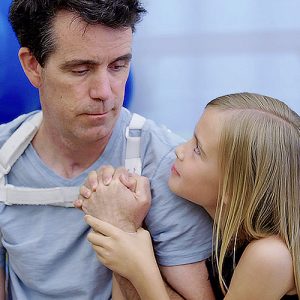 When Randy Hafdell had an aneurysm in 2014 his life became a chaotic nightmare. His wife and two children faced some terrifying prospects. How severe was his brain injury? Would it cause permanent damage? Could he work again? A grim fear set in as he was helicoptered to the hospital on that May morning, after a CT scan revealed a massive bleed that required a craniotomy.
When Randy Hafdell had an aneurysm in 2014 his life became a chaotic nightmare. His wife and two children faced some terrifying prospects. How severe was his brain injury? Would it cause permanent damage? Could he work again? A grim fear set in as he was helicoptered to the hospital on that May morning, after a CT scan revealed a massive bleed that required a craniotomy.
Julie, his wife, had no idea if Randy would be the same man she married 15 years ago. “My son cried every night,” Julie recalled. “When we visited him in the hospital, Randy wasn’t even aware of us being in his room. He was on a feeding tube and incontinent.” The hospital referred the Hafdells to CNS and after a tour of the Bakersfield facility, Julie knew it was the place for Randy. Even though it was a four-hour drive from their home, the individualized therapies and staff expertise in stroke led to his admission in November 2014. By June 2015, Randy was discharged and had overcome severe deficits common in stroke patients.
Those deficits included an inability to walk, feed himself, speak, and control his incontinence. In just two months at CNS, his feeding tube was removed. In three months he regained control of his bowel and bladder and was able to stand and walk with an orthotic device. “If we’d kept him in the hospital he wouldn’t have gotten anything near what he got at CNS,” Julie noted. “How can you quantify that?”
She recalled the family visits to CNS that transformed Randy and instilled hope in her 10- yearold twins. “We’d watch him in therapy through the glass windows of the clinic room,” she said. “In cognitive therapy, he began to point to what he wanted. He began to understand his world.”
Randy practiced many relearned skills in the CNS residential program, in an apartment setting where he learned to cook, communicate, reason, and form safety habits. CNS encourages the family to be an active part of the patient’s rehabilitation. Since the Hafdells live far away, Julie joined regular conference calls with Randy’s multidisciplinary CNS team. She received updates on his milestones in physical, cognitive, speech, and education therapies. “I lived for those calls,” she said. “All his therapists checked in with me and some called me at home. When I had concerns they took my input. They worked with me.” Today, he’s a changed man. Randy dances with the kids, cheers at his son’s football games, rides bikes, and goes to movies. Using his one functioning hand and arm, he also does laundry and helps Julie with the dishes. “He even makes his own sandwiches,” she pointed out. “Randy learned all of this at CNS.”
Watch their journey in "A Meaningful Recovery: Randy's Story".
CNS Monthly Newsletter
The latest CNS updates, including events, company information, and patient care developments
The Inside View
Quarterly magazine focused on brain injury research, rehabilitation, and advancements shaping the field
Sign-up for one or both to stay connected with brain injury news and recover